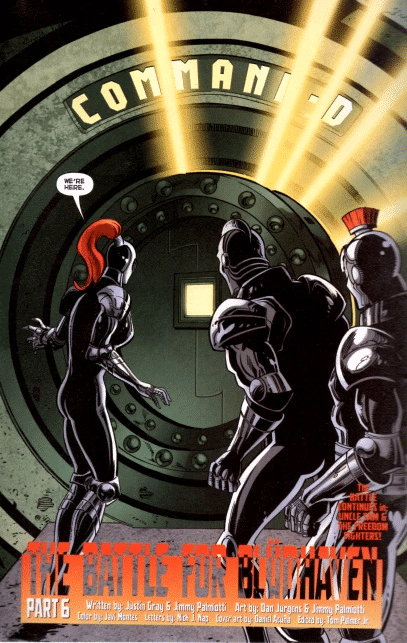Howdy, Nerds! Welcome to the final entry into our forever-part history of John Broome and Murphy Anderson’s 1964 masterpiece, The Atomic Knights! We’re at the home stretch, but that doesn’t mean you can’t get caught up! Check out parts one, two, and three!
A Brief History of the Atomic Knights, Part IV
When we last left our intrepid band of medievally-garbed heroes, they had lost one of their number but had been cemented into DC canon by way of Hercules Unbound, which connected plot threads from Atomic Knights and Jack Kirby’s Kamandi and OMAC to create a sprawling post-apocalyptic narrative.
But by the 1980s, it was looking increasingly unlikely that the Great Nuclear War of 1986 (which lasted only twenty days!) would lead to a whimsical fantasy land (a la Atomic Knights) or even a dark, twisted pesudo-mythological world (like in Hercules Unbound). No, by the 80s, everyone was pretty much resigned to the fact that if those bombs ever fell, the only whimsy would be seeing who could kill the most mega-roaches before radiation sores crippled you.
That’s why, in 1983, DC published “Days of Future Past,” where the Sentinels had outlawed and executed almost all of the X-Men–
No, wait. Sorry, got my notes mixed up there. It was actually THIS:
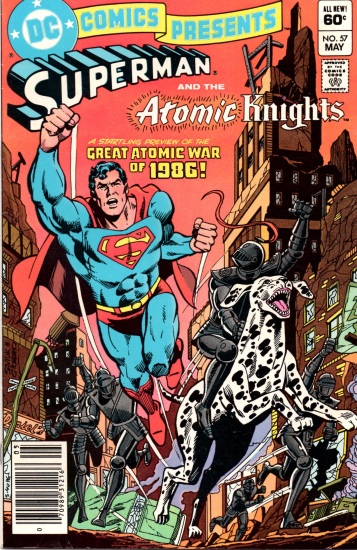
It was called “Days of Future Past,” though, and it opens the way not enough comics do: with sweet, sweet, Superman hobo beard.

[tw-divider]A Brief History of the Atomic Knights, Part IV: Future Days of the Past[/tw-divider]
Superman doesn’t have time to stand around pondering things though, because the very next page, he sees some “armor-clad” people who explain to him that everyone in Metropolis is dead. After that cheerful comment, the lead Knight (who is, of course, Gardner Grayle) recognizes Superman and blames him for letting everyone in the world die.
Then he wakes up.
Yes, it was just a dream…or was it? (And yes, I had to get a Creative Writing degree to be able to write this well.) Unable to shake a feeling of dread, Superman goes to work (this was during the time when he was a news anchor). The big story that day is how a computer malfunction sent a false alarm to American missile bases, causing us to almost nuke Russia (which actually happened far, far more times than necessary). Feeling that there must be a connection between his dream of nuclear Armageddon and this close call, he putters off to the Fortress of Solitude to see why his Kryptonian Super-Computer wasn’t monitoring the Pentagon’s early-warning system (because apparently, when you’re Superman, a little treasonous domestic spying is expected of you). He plugs himself in to check the diagnostics, and…
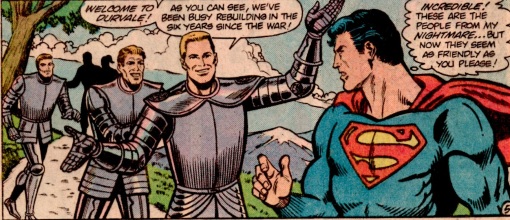
BOOM! Wakes up in Durvale. From the moment Gardner and the Knights show up, there’s a constant, conscious effort on the part of the writers to tie it back to both the original series and Hercules Unbound. Herc himself even shows up and references the tragic death of Atomic Knight Bryndon:
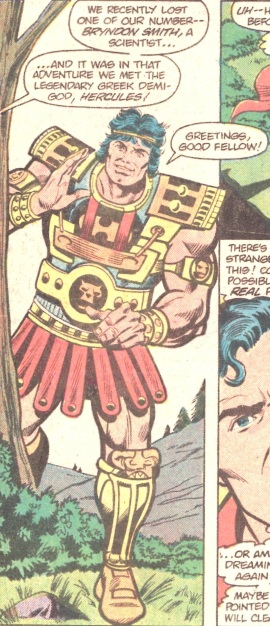
But, like a good Atomic Knights story, trouble strikes. About thirteen seconds after Superman shows up, the Knights get a report that a giant monster is terrorizing New York City. It’s actually a pretty well-done scene, evoking the feel of the giant monster fights from the original Atomic Knights and taking the time to throw in a reference to the de-evolved Cro-Magnon folks from issue three. But what makes this scene interesting is how incredibly dubious Superman is about the whole thing.
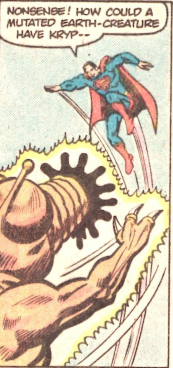

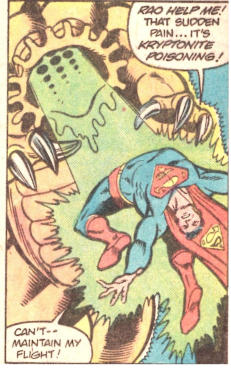
Keep in mind, this is Superman we’re talking about. He’s a guy accustomed to doing the impossible on a regular basis, and even he’s like “Wait, Kryptonite breath? That doesn’t make any sense.” It gets worse after the fight (which ends after a single Herculean punch, so that’s cool), with Superman pretty much directly confronting Gardner Grayle about the state of the world:
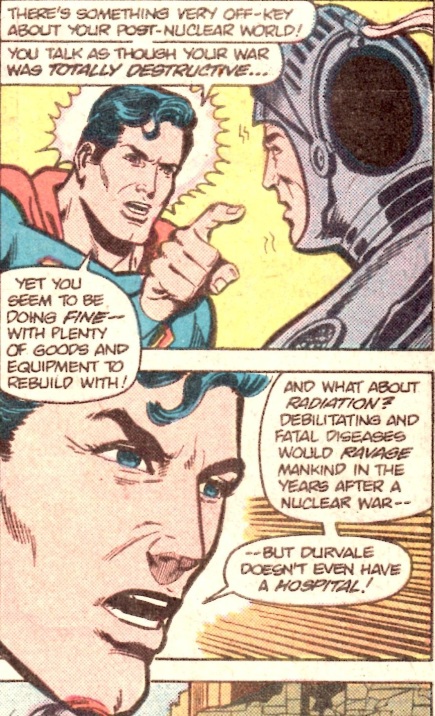
This issue came out during a time when the specter of nuclear annihilation is very, very real, and every little kid knows that when the bombs drop, the lucky ones will die quickly. What better way to cope with those fears and frustrations than to resurrect a title from the 60s and shine a cold, harsh light on its quaint naivete? In many ways, Superman is the jaded reader, the kid who read Atomic Knights and Hercules Unbound and realized the real world can’t be reconciled with the one in the comics. It’s a sobering, mature realization, and actually serves to ask critical, relevant questions.
But then Superman gets thrown out of his computer, so there’s that.
Superman eventually discovers that Gardner Grayle was a physically and mentally average soldier (sound familiar?) chosen to participate in a special military psychological experiment: how would the average soldier react to a post-nuclear war situation? Apparently the personnel involved were hypnotized to forget about the project and Gardner has been hooked up to advanced computers in a state of sensory deprivation ever since.
Now, I’m sure many of you would share my feelings right now. You’re calling “cop out.” You’re calling “retcon.” You’re throwing full bottles of Icehouse at homeless people and ritualistically scarring yourself. Well, first, stop that. Second, that was me until I read this:
“Because the utter devastation of a nuclear holocaust that the simulation posited was simply too ghastly for the mind of the average person to cope with!”
 This is a story that looked at the campy fantasy fun of Atomic Knights and put a bullet right between its eyes. This is a story that looked at Gardner Grayle and made him a sad, broken man so utterly devastated by a world of fire, death, and festering sores that he crafted a new world where the bad guys were never too bad, the good guys always won, and he could be a hero for once.
This is a story that looked at the campy fantasy fun of Atomic Knights and put a bullet right between its eyes. This is a story that looked at Gardner Grayle and made him a sad, broken man so utterly devastated by a world of fire, death, and festering sores that he crafted a new world where the bad guys were never too bad, the good guys always won, and he could be a hero for once.
It’s masterful, really. Plenty of modern comics have looked at the past with a critical eye, but this explanation preserves the fun of the original stories and does nothing to take away from their adventure and enthusiasm, even while it gives them a new edge, a little bit more psychology and depth. And maybe that depth is unnecessary. Maybe making a story about mole people actually a sobbing, silent cry for help is overkill. But it makes it a little bittersweet, and I don’t know about you, but it makes me want to root for Gardner and the Knights even more.
The Knights would show up a few more times in the mainstream continuity. Justin Gray and Jimmy Palmiotti gave them a supporting role in Battle for Blüdhaven:
And Grant Morrison seems to be a pretty big fan. In Final Crisis, the Knights are still diligently patrolling the area around the Command D bunker:
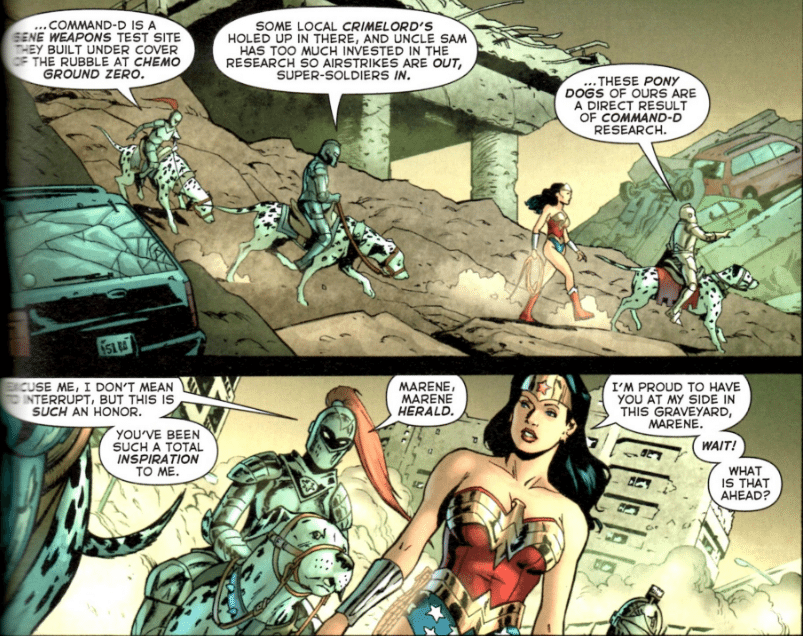
…before making a cameo in his Multiversity, as the protectors of Earth-17.
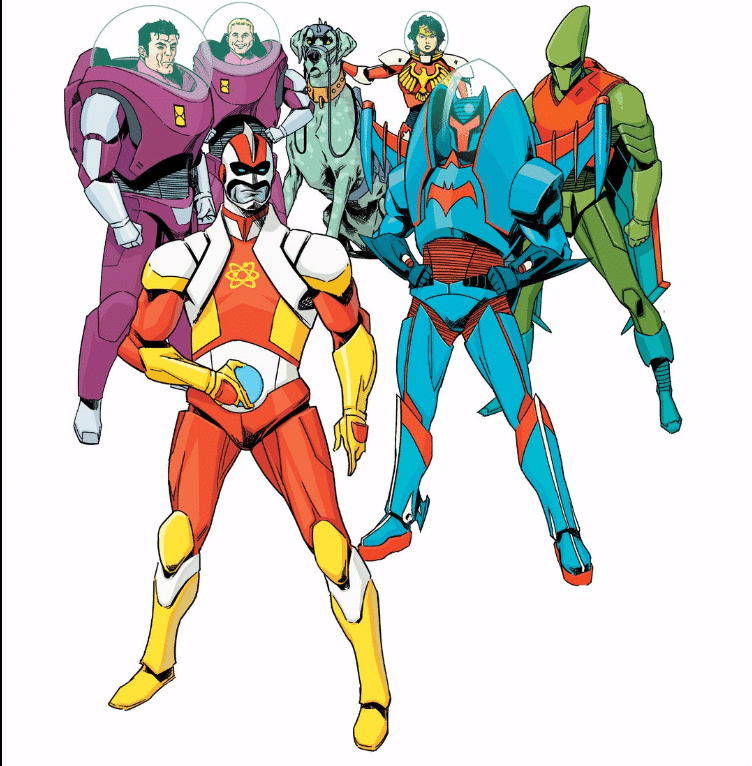
And that’s the Knights!
We’ve seen them go from a rag-tag band of protectors to the rebuilders of civilization to a desperate fevered dream of a lonely, isolated man. All in all, it’s a solid chunk of comic history, and too often overlooked. But the spirit Knights will live on, as long as we remember one thing:



